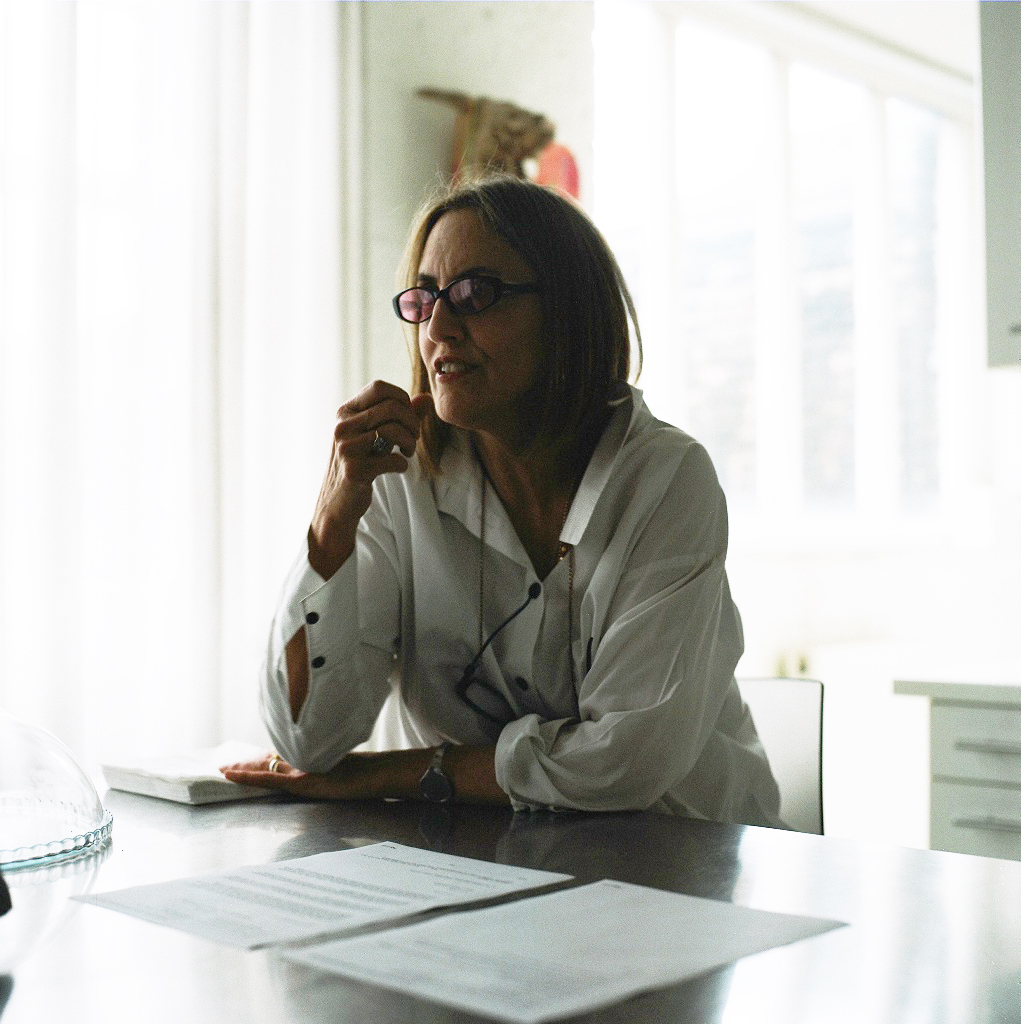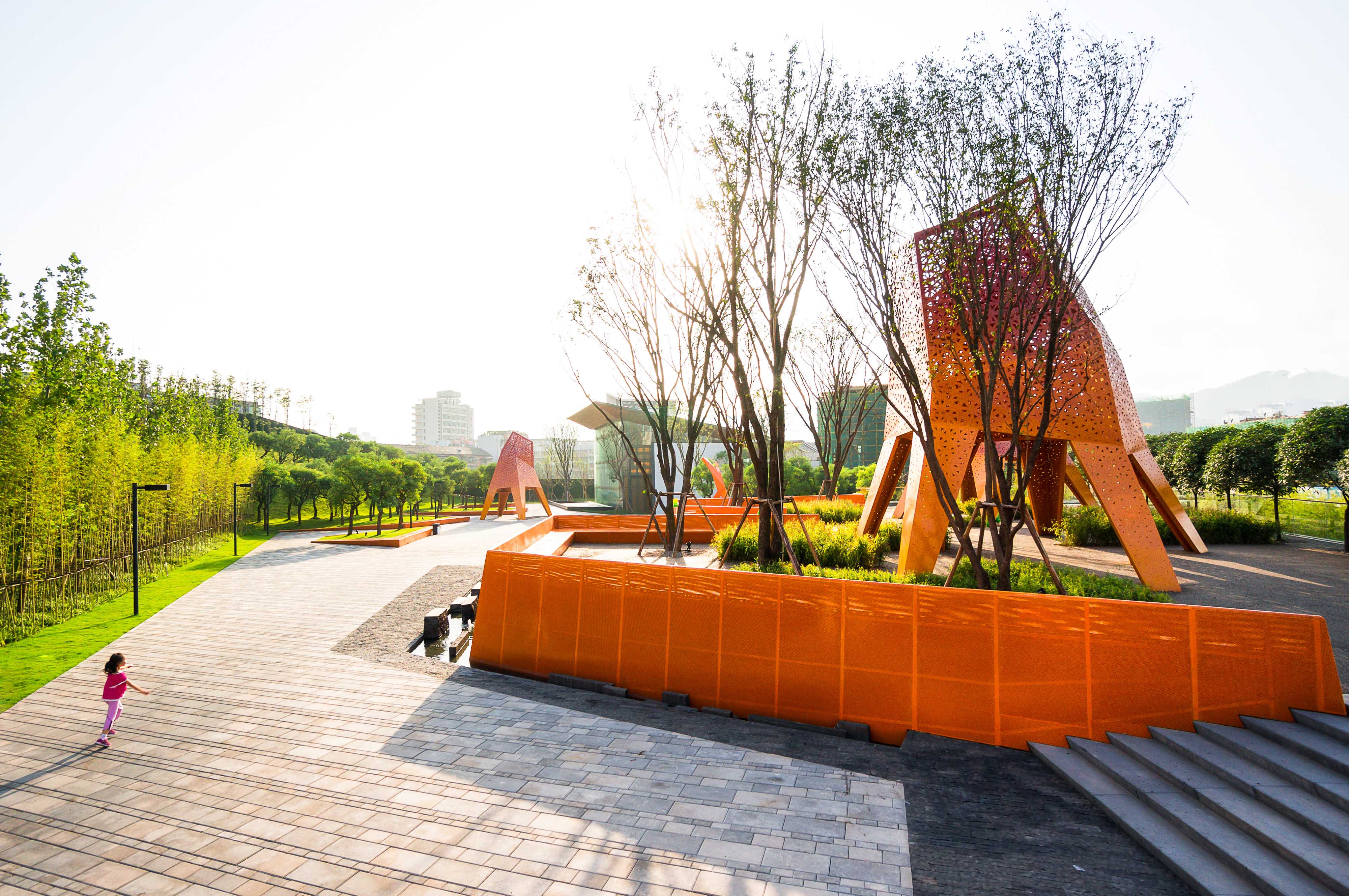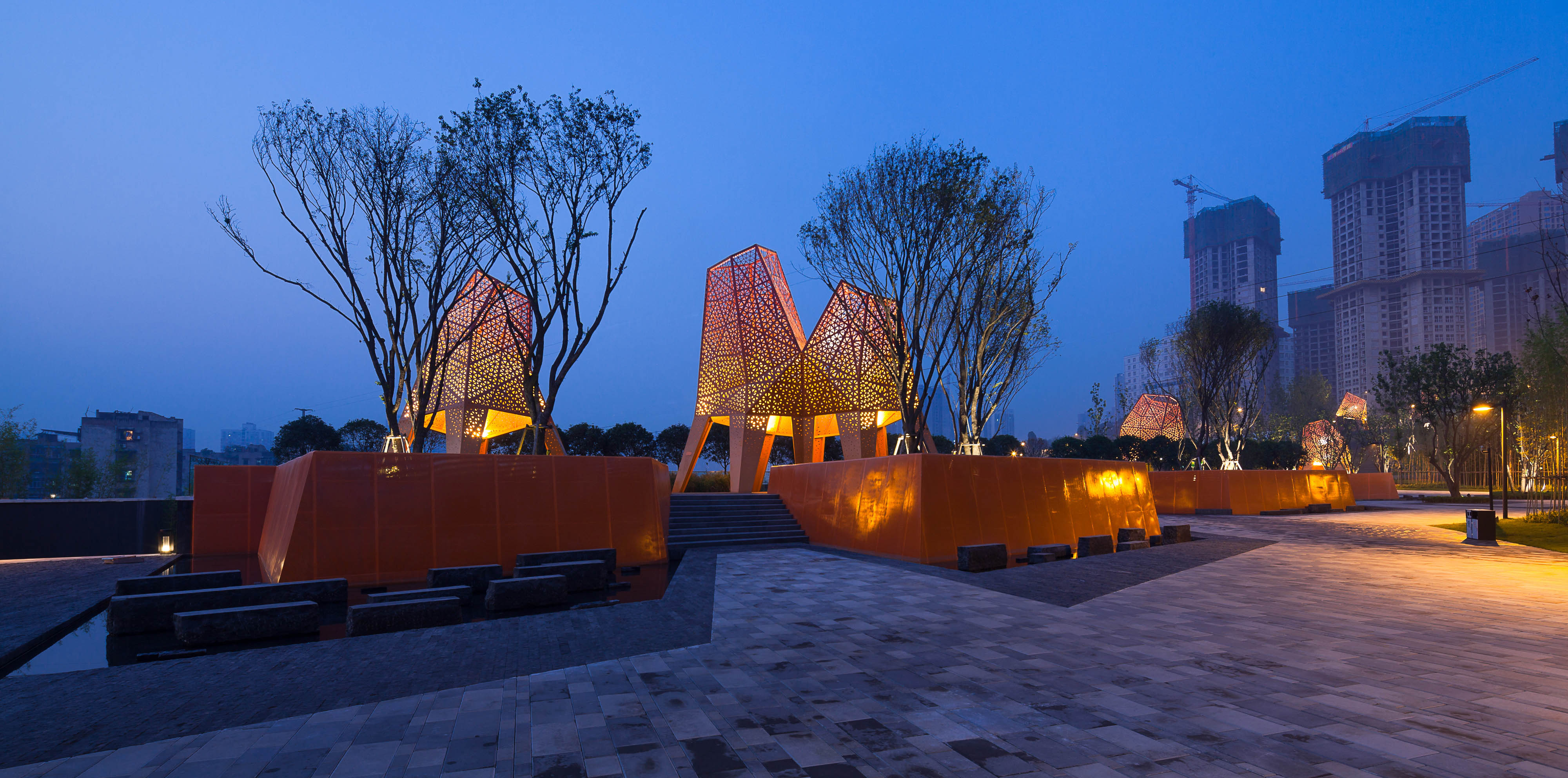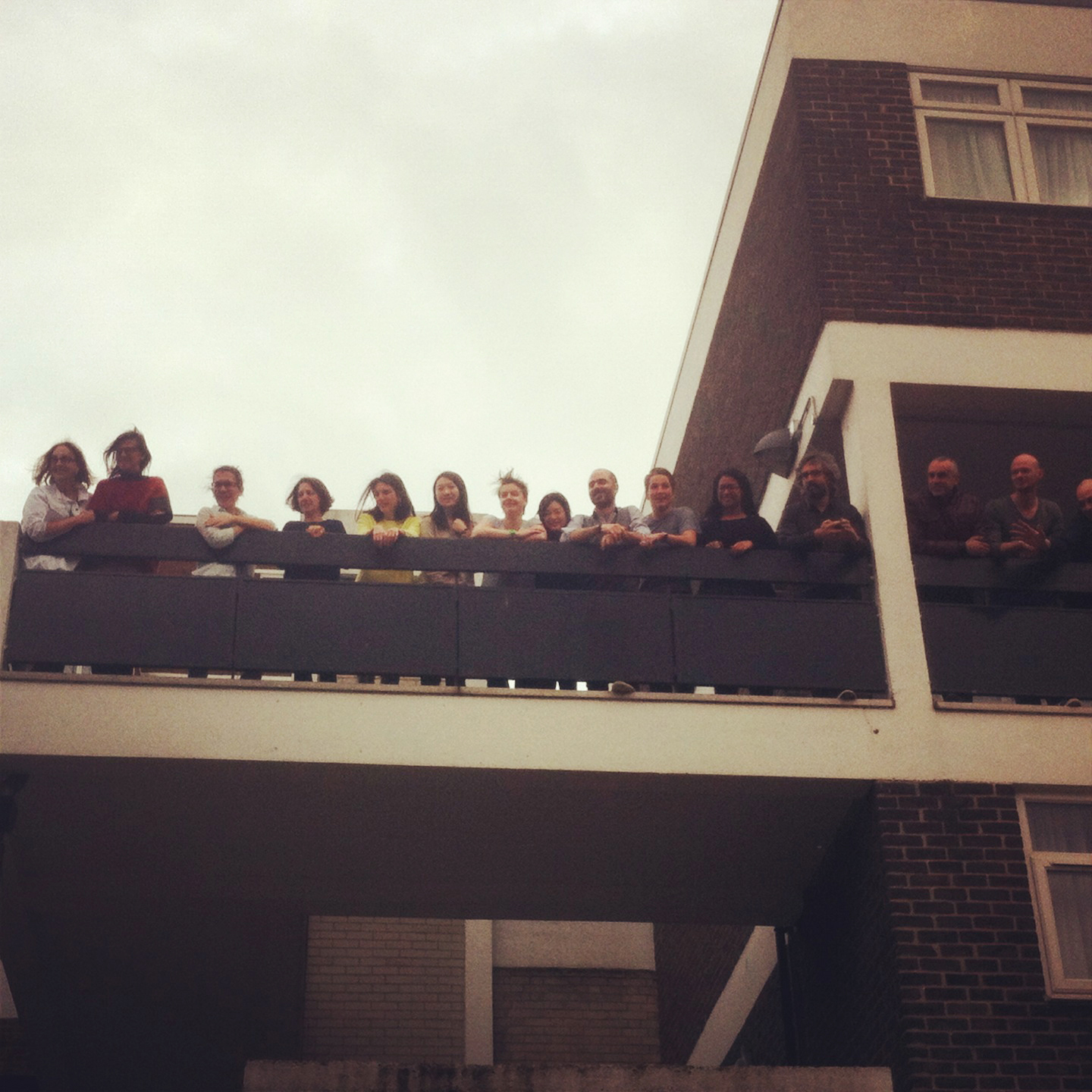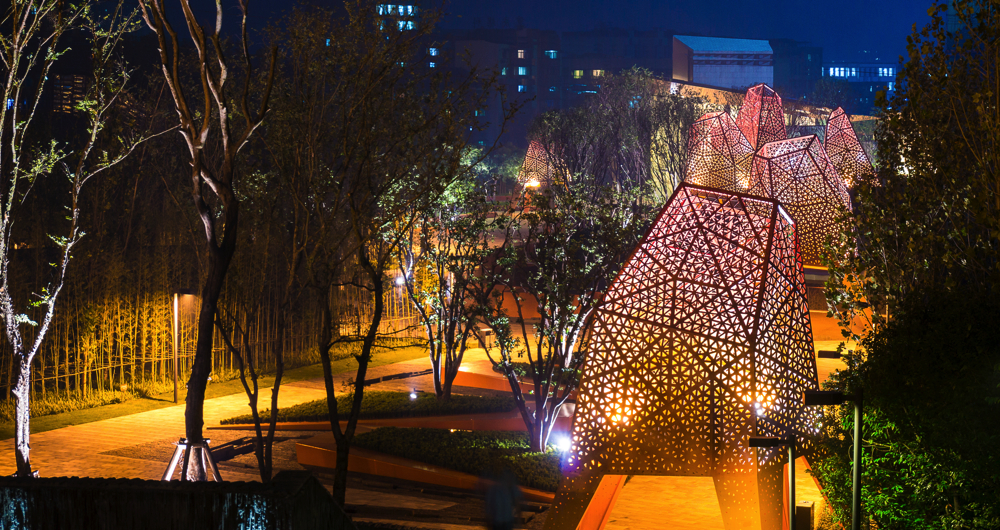Interview by: Costanza Madricardo, Architecture Editor reporting from London
Photography: DP
I first met world renowned Landscape architect and Harvard-professor, Martha Schwartz, at the Architectural Association in 2012. Two years later we meet again, to discuss Martha Schwartz Partners fascinating and much-admired project in China, Fengming Mountain Park of Chongqing.
In the interview she and the designer of the iconic Fengming lantern-pavilions, Ignacio Lopez Buson, talk about their sudden breakthrough in China, the role of women in the design world and about how landscape architecture can change our cities.
When did you start being interested in landscape architecture?
I first became interested in landscape architecture during my last year of graduate school, which was a 3 year course. All my studies before have been in art. My father is an architect and I had never heard about landscape architecture and never wanted to be a landscape architect, but I wanted to learn how to build big art.
What is the role of art in your work now?
I don’t know what role it plays, except that when we are designing something we are always trying to do something new, something that is fresh or has not been seen before or that is somehow magical or provocative.
We are always trying to invent something. I don’t know if we are necessarily set out to do art, but we want to make landscapes that are a dialogue or are in relationship to the contemporary world of culture in general.
I believe that we make our landscapes, we produce them, we live in them and they are man-made: so why can we not use the landscape as a way of communicating ideas, like sculptures or painting or architecture?
But evidently there are a lot of rules that we are not even aware of and that makes it very difficult, because the landscape has a very defined role in our imaginations.
Now you have offices based in three different continents: Europe, China and the US…
No, not really. When the financial crisis happened, we shut down the office in the US and now it is in a kind of sleep mode.
London, UK is our major office, we have been here seven years. I have lived here for seven years. This always seems to be a surprise to people!
We are going to be pioneering over in China, and Ignacio is going with another two people from the office to start that up and to assist us in what we are doing there.
It is really our first big project in China because of the Fengming project. We popped up on the screen, and of course China has a very large screen. They do move very quickly and we need to get things built.
So our group over there is going to help us and make sure that these things will be built correctly in the way we have intended. It is great to have a good concept, but it is better when the concept gets built that you can see it.
You are working on projects at a global level. Can you compare the public space in these 3 different continents? For example, do you apply a different design approach for a project in China and one in the US?
Well, yes and no. We are the same people. You cannot switch yourself off or the way you think. We do bring ourselves in every single project. But different cultures do require different approaches.
For example, if you believe it or not, you cannot ignore Feng Shui in China and this is just the tip of the iceberg.
Chinese culture has such a deep history, the things they believe in… Legends, connections to meaning, to colour, to form, to flowers. There is a whole dictionary that we are not even aware of. When you realize something means death over there but it means life over here, you have to be aware of that and not use it there.
China is on a very steep learning curve and at first things were not built well, because people were not well trained to be able to translate what they wanted. For example Herzog and De Meuron would freak out because their building was not built right. They (the Chinese) built it quickly, which was good, but they did not quite understand what a Herzog and De Meuron’s building really was.
It was just the way it looked but not the way it felt, and of course HM would think differently about that.
Now they are becoming more and more sophisticated, but then you have to make sure that you are not designing beyond what they can actually produce, because otherwise you are screwed up. If you are designing in Switzerland you can rely on their craftsmanship and build in another way. So the faster you learn what makes the difference, the more chances you have to be successful.
Recently Zaha Hadid said that in the UK there is a misogynist attitude to women architects and in general designers, and that the design and building industry is very much male dominated. What is your opinion on this?
I agree with it, 100%.
Do you think it is the same in the US as in the UK or in China?
It is just the same in the US, if not worse.
But China is an interesting place, I have never gone to a place where there are as many female senior executives sitting at the table – if not more.
It seems to be a pretty fluid place.
I. Lopez Buson: My client is a woman… 2 of them… They are tough!
M. Schwartz: China seems to be a little less upset with women in high positions than here in the UK or the US.
I was recently in Chicago for a project with Jeanne Gang. It was for a skyscraper and our chances were almost zero: Who would give a woman a skyscraper to do? And we did not get it – also for other reasons. Women landscape architects instead always do kitchen gardens. Myself, when I started, was not able to present my own design because nobody would buy that idea from a woman. Everybody says that there are so many women at school. When I was at school, over half were women and there are so many offices out there. But how many of these offices are owned or run by women?
Do you have any suggestion on how to improve this condition?
We need places and spaces of work where women can be more integrated. The problem is that women actually choose to not go on. Because there is prejudice and a lot of women feel that they don’t want to make these choices between going to work or raising their children. And this is a terrible choice that women need to make. The most privileged women decide to not go to work and not the other way round.
Can you describe the Feng Ming Project and the role of parametric tools in its design?
I will describe the project but I would like to talk about how we work in the office as a group and how ideas are coming and how we produce what we produce as a group. I am very anxious to disabuse people who are the great fountains of ideas.
And from these fountains of ideas all flows out to the table and all the little people then do my ideas: That is really not true!
Myself and my husband both love art and good ideas. I am an ideas junky. I love good ideas. I like different kinds of art and music… Jay-Z , Chopin. I really like to work with people who bring ideas to the table and then we can discuss them, we can debate them, we can explore them. I find that we do collectively a much better job and we create much more interesting work the more we have included other people into the design table because it’s great to see what other people have to say, younger people have to say, and bring tools to the table that I certainly cannot use but that are wonderful tools, like the computer and parametric design.
Everybody is invited to give ideas, pin them up on the wall and then we can see. Then we bring them to our clients.
You can solve all the problems, but if they don’t like what they see, if the aesthetics are not anything they can connect to, then you are lost, you are not going anywhere as it is not a linear process.
So that is how we work and people make major contributions to the final design as Ignacio has. Ignacio designed those mountain/lanterns that ended up making us famous in China.
The beginning of it was being asked by Vanke to do this project.
Vanke is a super well known developer in China, they are probably the largest developer for housing in China and the CEO is very well known as a game changer and he is interested in advancing ideas about housing, sustainability and environment.
He is a very adventurous man. I met him when he was going to the Divinity School at Harvard and learning English at the same time.
We were first brought in to correct and fix the landscape for their headquarters that was designed by Steven Holl in Shenzhen. This brought us to design the next project which is in Chongqing.
It is a city of 30 million people and it is very hilly. They had a big Masterplan but in Chinese style: they like to build the sales centre first as they are developing and building, so that they can pre-sell their products.
The sales centre is very important because it is like a sign, so there was a need to have something that was going to attract people. As it’s at the bottom of a hillside, the first thing that you do is walk to the park, then down the hillside to get to the sales centre.
In the meantime, the other very interesting thing is that the site looked like post world war 3 because it was such a massive site under construction, being completely ripped up. There were earth works and cranes everywhere. It was important to divert people from looking at that, to looking down the hillside and being in a more contained space visually, so that they could see how beautiful it would be in the future.
They were asking us to get people off the road and have something sculptural.
We thought that the basic structure would be to have the parking at the top of the hill and have a wall to hide the parking, that way visitors looking up don’t see it. From there people can zig-zag down the hillside in a little golf cart. It is like a mountain stream /road and the zig-zag thing became the leitmotif to bring people down.
So this was the basic diagram. We decided to do something sculptural, playful and visible.
The question was how do we represent the mountain and do something that will be visible, so that people are led down to where they need to go? The task was to create a choreography of the landscape. The choreography of the whole landscape is very important.
Fengming Mountain Park, Chongqing, China – Courtesy of Martha Schwartz Partners
This was the general introduction.
Ignacio started developing these sculptures that became very iconic. From that point he developed these sculptural objects and I was just like a design critic. I do because I am a teacher, and this is my major role in the office, to be a good critic.
I. Lopez Buson: Actually everything started from Martha’s sketch of the pavilions working as wayfinder. Pavilions that people could use as shelters, because it is very hot over there. From this concept, it was all about testing and starting developing the idea of a mountain. As you were saying, it has never been a linear process, especially because the project was done in a very short time.
In this condition, the parametric tools were very helpful. There was never one concept, but we were sending different options.
M. Schwartz: At some point they just built it!
I. Lopez Buson: It is interesting because we were providing options and they were rejecting them, until there was a moment when they said “YES”.
From this moment the dialogue with the client was all about adjustments, and then we knew we had the project under control.
We started feeding the concept with other ideas, as the lantern thing: introducing colours, playing with gradients of colours from orange to red to obtain a certain effect at night. This was actually very beautiful. During the day these pavilions are red-orange and at night, all of a sudden, they turn into glowing yellow lanterns.
To define the pattern the idea was to merge the structure with the pattern itself, by creating a differentiation between the two and at the same time generating something more organic. The result is a hybrid structure, where you cannot differentiate what is architecture, what is design and what is decoration.
Then, as Martha was saying, all of a sudden, they started sending pictures of the real thing getting built. They were 1:1 mockups… It was crazy! The effort was big but it has been worth it, considering the result!
Fengming Mountain Park, Chongqing, China – Courtesy of Martha Schwartz Partners
Which is the material you used for the lanterns?
I. Lopez Buson: We started recommending aluminium; we were very lucky that they had laser cutting machines there. That allowed us to play, but we had to change from aluminium to steel.
And is it open now to the public?
M. Schwartz: Yes. I am proud of it because it shows what interesting things design can do. It is not just decorating… it actually can change things.
The park was meant as a temporary landscape. But they decided to keep it, because people loved it so much.
Now it is going to be a permanent park of the bigger development, so they are designing around this and making changes that will fit into the whole thing. It will become like a little Central Park.
If you design something that people love and that they want to keep, that is really part of sustainability.
That is something that will sustain itself over the time because people like it.
I was really happy to hear that, it was a big compliment.
I. Lopez Buson: Now there will be Fengming part 2. It is a big extension of it. I remember that one week before the final submission, Martha was reviewing the pavilions and she proposed one with a double head, the Siamese twin: It is the most beautiful one. I was a week from the final submission! But thanks to parametric tools in this case we were like “Ok, let’s do it!”
M. Schwartz: That is the great thing of having good people around the table designing, because the chances of being really good increased.
Nobody really works in isolation, so it is good to surround yourself with good people.
What do you think is the role of the landscape within the urban context?
The role has become clearer and clearer. It was always there but people were not aware of the role that the landscape played itself.
It was always about leftover spaces or the spaces between buildings.
It is a fairly young profession. Now that the greater number of people are living in cities, the pressure on open spaces is becoming more and more. It cannot just function as decoration. It has to function economically, environmentally, socially, and culturally: It’s multivalent in terms of its potential.
Mayors are using the quality of their open spaces in their offer and to bring people to live in their cities, because there is intense competition for well-educated people. That is a new resource, it’s like gold or oil. We are competing in knowledge based economies, so those people have a choice, people don’t want to live in horrible places and that cannot just be done with buildings.
You need beautiful streets, good public transportation, open spaces, so you can live in a healthy environment. My son is living in Beijing and that’s terrible, I am really worried for him because it’s toxic.
We are also trained as landscape architects to think more holistically about different systems, how these overlap, think about their connectivity.
Because you are always turning into somebody’s property line, but the landscape does not really have boundary lines. So we are used to thinking more broadly about what the bigger issues are.
We try to think what goes beyond the site and how to bring that thinking to a particular site. And not everything ends up being built.
We have been asked more and more to be part of teams, to be important part of teams, to be team leaders to help defining the scope before development happens and start organising how open spaces work and fit the development.
And of course environmentally, how do we organise the site so that it maximises its environmental functioning.
We are getting a stronger voice in terms of lobbying certainly in the US on how to rewrite or re-approach zoning laws.
This stuff works against the bigger objectives, which is building more densely but also to collectivize meaningful landscape.
But also creating an awareness that your visual environment has a great impact on you. And so much of the time we spend in our cities is characterized by the public landscape: what you see when you are walking, when you are travelling, when you are outside of the building.
That experience is very important psychologically to you, in terms of your own health. Planning the streets and designing the streets and paying attention to how the landscape is operating in the cities is absolutely fundamental to how the city works, it’s not just decoration.
I think that if we are more aware about the environment, we need really to get a grip in terms on our own behaviour and what we are doing…there is more focus now on the landscape, but there is so much that you need to learn about it.
Architecture and landscape are very much integrated but they are also two different disciplines.
Which city do you think is the most liveable in your experience?
I cannot say I lived in that many cities. I was born in Philadelphia, I lived in Washington DC, New York, Boston, San Francisco and London. For me London is the most liveable city.
Why?
Because the scale of it is nicer, low rise city. The scale height is nice. A little bit more quiet. Not as noisy and crazy as NY, which is actually the city that I love the most. London has a fantastic public transport, you can go everywhere. And London is a real city, it’s diverse, there are people from all over the world, which I really like. It has a great airport service, it’s a hub and for me that’s very important because I work internationally. And it has a lot of greenery here, there are lots of beautiful parks. The museums are also fantastic, the cultural scene is great and then you get on a train and you go to Paris… I mean that’s awesome… the weather sucks… but it’s a great city!
Fengming Mountain Park, Chongqing, China – Courtesy of Martha Schwartz Partners





